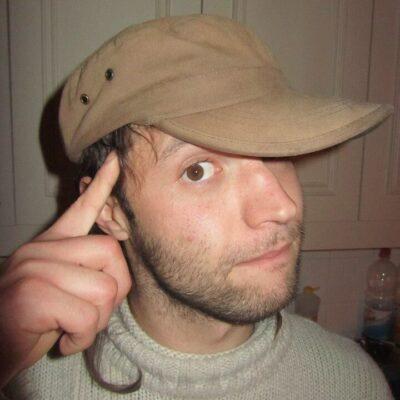Son-Kul (also spelled Song-Kul) is a breathtaking secluded lake in central Kyrgyzstan’s mountains, sitting at an altitude of 3,016 meters (9,892 feet). Surrounded by vast pastures, it’s a seasonal grazing ground for nomadic herders who bring their livestock to the area during summer. Visitors often stay in traditional yurt camps, offering a unique opportunity to experience Kyrgyz hospitality and culture. The lake is also a haven for birdwatchers, with species like cranes and falcons frequently spotted.
If there’s one thing Kyrgyzstan is most famous for, it’s indisputably its horses. So, following our trek to the alpine Ala-Kul Lake, it felt fitting to conclude our trip to Kyrgyzstan with a horse-riding adventure. Son-Kul Lake seemed like the perfect destination.
The third in a sequence of shared taxis we changed from Cholpon-Ata, on the northern shore of Issyk-Kul Lake, dropped us off along a desolate road above Kyzart, the gateway village to Son-Kul. We walked a mile to the bottom of the valley, where Kyzrt lay amid sparse groves and orchards, and started looking for a bed for tonight and horses for tomorrow’s departure.
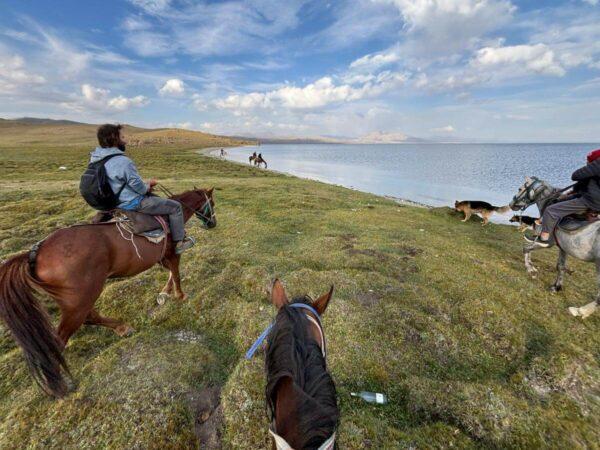
Affiliation disclosure: By purchasing goods or services via the links contained in this post, I may be earning a small commission from the seller's profit, without you being charged any extra penny. You will be thus greatly helping me to maintain and keep enriching this website. Thanks!
If you’re starting from Bishkek and want to avoid the hassle of transport and logistics, consider this all-inclusive tour:
Accommodation in Kyzart
We had booked a room at Bereke Guesthouse, which, judging by the reviews, appeared to be the most established homestay in Kyzart. However, upon arrival, we realized we had accidentally booked for only one person, and they charged per guest rather than per room. They insisted we pay double the price, even though we’d be occupying the very same room. Moreover, the welcome felt a bit feigned, so we decided to cancel on the spot and look for something else.
We ended up at Azis Guesthouse after a 3-kilometer walk to the other side of the village. The reception there felt much more genuine. The family was just starting out in the room rental business, and we were among their first guests. While her husband roamed the pastures with the herd, the hostess managed the guesthouse alongside working morning shifts as a nurse at the local clinic and raising some five children.
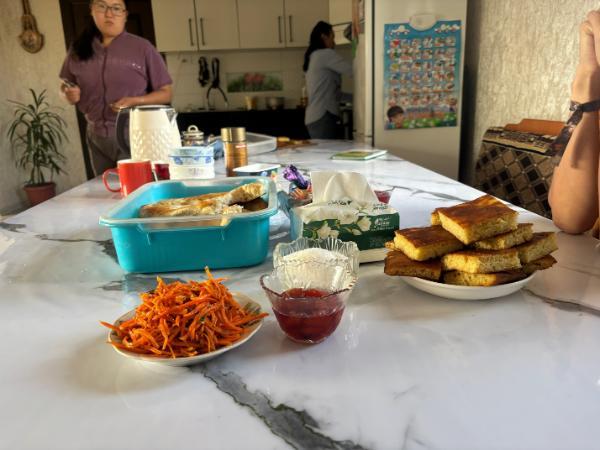
She was assisted by her young sister-in-law, who studied Russian philology in Bishkek and was home for the summer holiday. Both women were exceptionally polite and accommodating. They prepared exquisite meals and showed genuine interest in their interactions with us. The hostess also impressed us with her dexterity on the komuz, a traditional Kyrgyz string instrument. I wholeheartedly recommend the place for an economical and authentic local stay.
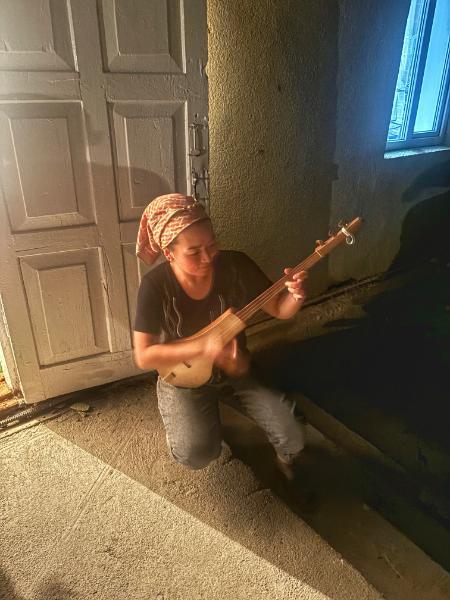
If, again, you’re looking for a more premium stay with plush facilities and English-speaking staff, check out Kyzart Hotel. You can also explore more options on the interactive map below.
Stay22 is a handy tool that lets you search for and compare stays and experiences across multiple platforms on the same neat, interactive map. Hover over the listings to see the details. Click on the top-right settings icon to adjust your preferences; switch between hotels, experiences, or restaurants; and activate clever map overlays displaying information like transit lines or concentrations of sights. Click on the Show List button for the listings to appear in a list format. Booking via this map, I will be earning a small cut of the platform's profit without you being charged any extra penny. You will be thus greatly helping me to maintain and keep enriching this website. Thanks!
Arranging a Horse Tour to Son-Kul Lake
Having secured a comfy bed, we plunged into it and worked on the arrangements for tomorrow’s excursion.
Earlier, the host at the original guesthouse we’d booked wasted no time pitching his tour arrangement services. “Do you want horses?” was the second thing he said after “Hi.” I assume most hosts collaborate with tour operators and are eager to pass guests along for a commission. Without a point of comparison, I couldn’t gauge the value of his offer, so I replied, “Thanks. We’ll keep your offer in mind. We’ll also look elsewhere, and if we don’t find anything better, I’ll let you know by evening.”
In response, he cut 10% off his initial offer. After I repeated the same reply verbatim, he dropped another 10%. By the third repetition, he frowned and walked out, leaving his wife to show us to the rooms. His attitude became yet another reason for us to leave in the end. I don’t recall the exact price, but his final offer was still higher than any we received afterward.
A novice in the tourism business, our host wasn’t yet prepared to mediate the trip arrangements. We searched online and found the WhatsApp numbers of two tour operators: Caravan Tourism Agency (+996707259282) and Shepherd’s Life (+996777013747). For two horses and a guide, one quoted $180 with accommodation and food in a yurt camp, or $140 if we brought our own tent and food. The other quoted $200 and $120, respectively. One was cheaper for the all-inclusive tour, while the other was cheaper for the self-sufficient option. As we weighed our options, we walked to the village’s sole grocery shop (location) to grab a drink and buy some provisions.
Under most circumstances, we wouldn’t give a second thought to taking the self-sufficient option—that’s how we usually travel. However, being in Kyrgyzstan for the first time, staying in a yurt camp, like going on horseback instead of trekking, felt like an experience worth trying. So, we leaned toward the all-inclusive option.
Another option is to book your yurt stay directly, which would be practical if you’re planning to hike to Son-Kul on your own. If you, unlike us, are an experienced horse rider, you could also rent horses without a guide. I didn’t inquire specifically, but I imagine they wouldn’t mind trusting you with their horses as long as you leave a deposit.
While we were still contemplating our choice, enjoying an ice cream outside the shop, a lad pulled his van up in front of us. Politely and pleasantly, he introduced himself as Sanzhar, the shopkeeper’s son. His dad must have called him as soon as he saw us—two potential clients—lingering outside. Sanzhar offered to take us to Son Kul himself for $140, all-inclusive. With the best price and his affable demeanor, we struck an immediate deal. I recommend him wholeheartedly. His number is +996709498758. And this is his Instagram.
All set, we enjoyed a delicious traditional dinner at our homestay and rested up for tomorrow’s adventure.
The Trip to Son-Kul Lake
The day had just broken. Full from the generous breakfast, I was sitting on a step, sipping coffee and enjoying the morning’s sweet birdsong. Then, a loud drumming of hooves drowned out the melodies, growing steadily louder until it stopped right outside the gate. I stepped outside and met Sanzhar with three sturdy stallions and a shaggy German shepherd.
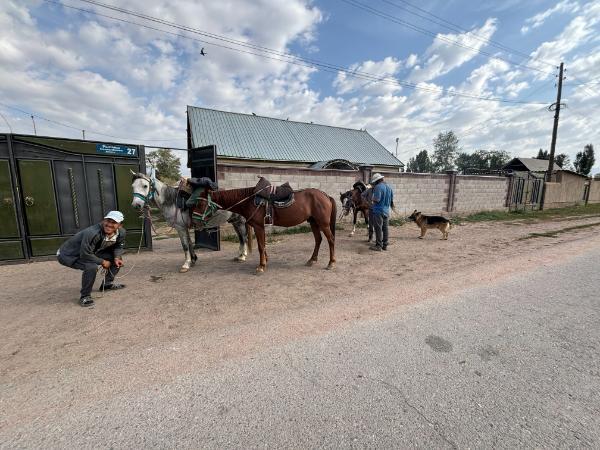
He introduced the dog to us as his best friend, Rex. Sanzhar was mounted on a two-year-old grullo named Burul. The others were two unsaddled chestnuts, Zherde Sulu and Bes Kaska, seven and two years old, respectively. He saddled them on the spot with tack borrowed from our landlady. We stuffed our luggage into the side pouches, put on sunglasses, hats, and plenty of sunscreen. Sophie mounted Bes Kaska, I took Zherde Sulu, and we urged them to get into step.
We proceeded along the main road and soon turned right. Of their own accord, all three horses veered to the side as we passed by a roadside stream. They lowered their long necks, refreshed themselves with a drink, and we continued straight toward the mountains.
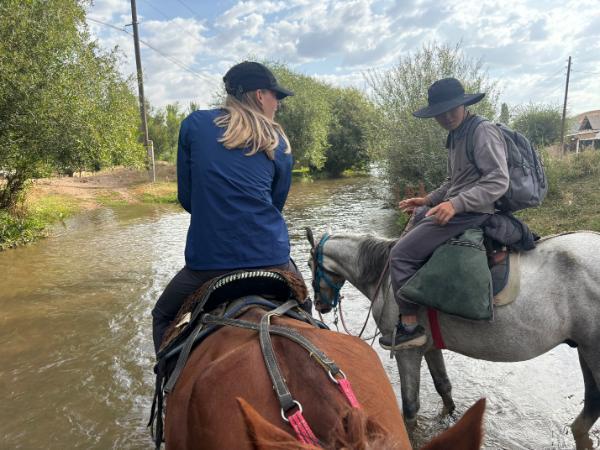
As the slope grew steeper, Zherde Sulu and I began to lag behind. While Bes Kaska walked with his nose practically glued to Burul’s haunches without Sophie needing to encourage him, mine ambled along at his own slow pace, ignoring nudges and flicks of the reins. On top of that, I constantly had to steer him back on the path with the reins, as he kept trying to veer away from the uphill climb. Perhaps it was his age—after seven years, he must have grown tired of carrying loads. Or maybe he held a grudge because I wouldn’t let him graze. While Sophie loosened Bes Kaska’s reins every time he stopped to munch on his favorite grasses, I kept Zherde Sulu’s reins taut as the gap between us grew wider.
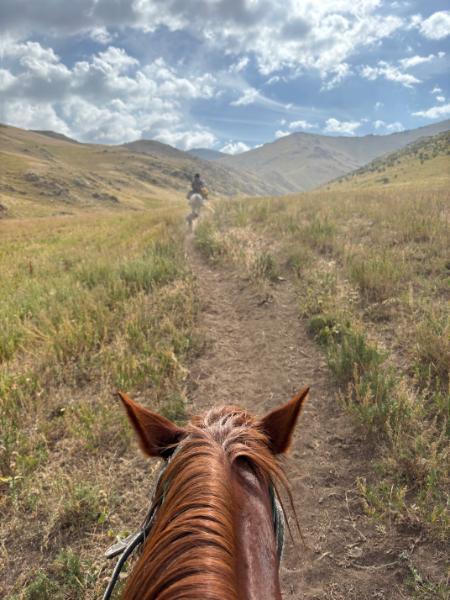
As I realized later, my own compassion played a part. Afraid of hurting him, I had been far too gentle. But when I was on the verge of losing sight of the others and grew exasperated, I shouted, bounced in the saddle, and drove both heels into his sides with all my might. He let out a sharp snort of displeasure, then broke into a trot. We caught up just in time for a break before tackling the steepest stretch of the slope.
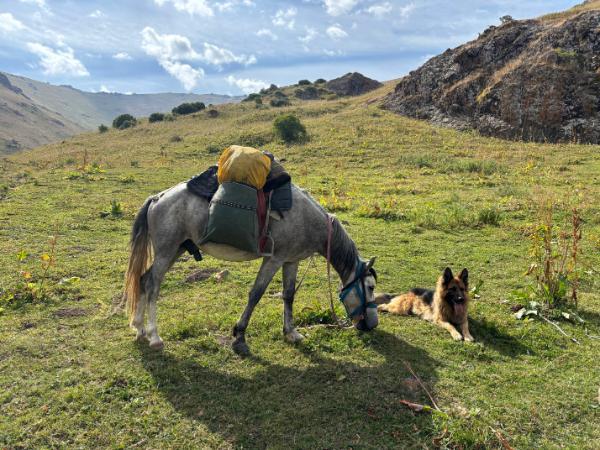
The climb ahead was brutal. My heart ached for the horse as he labored, gasping for breath, taking it one foot at a time, farting like an exhaust pipe. We followed a rough, zigzagging trail. The cliff to the side looked more terrifying from the horse’s tall back. If he stumbled and I fell, the injury would be bad; if he moreover toppled over and crushed me, it would surely be fatal. I focused on the far-reaching, majestic view of the valley behind me to avoid looking down.
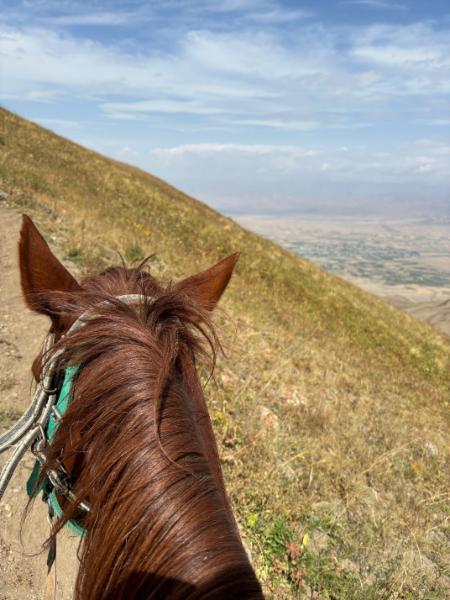
After eleven kilometers of travel and thirteen hundred meters of ascent, we reached the ridgeline and finally caught sight of our destination. Blue and serene, Son-Kul emerged at an altitude of three thousand meters, appearing distant and dreamlike in the vast, desolate mountain pastures. Two or three scattered nomadic camps were faintly visible along the shore closest to us. We pressed on without pause.
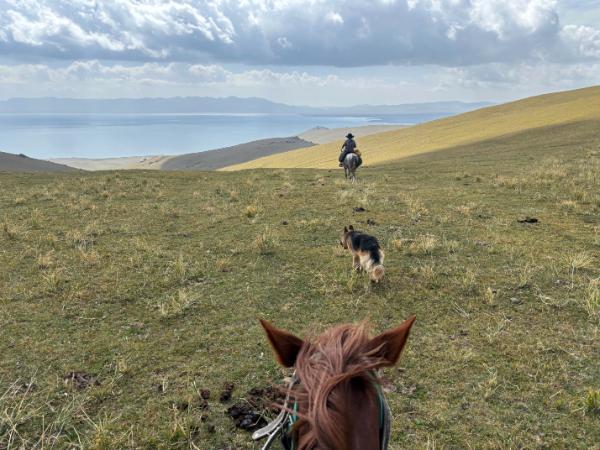
Slowly and steadily, we descended the steep slope. Large herds of horses and cattle greeted us from all directions with neighs and lowing. Toward the end, as the gradient began to soften, Zherde Sulu—hungry, no doubt, from the foodless climb—quickened his pace on his own. Seizing the opportunity, I adjusted my posture, grabbed the saddle horn, and urged him to speed up. Teetering and bouncing violently, I managed to keep my balance with a mix of precariousness and pure exhilaration as the steed charged ahead at full gallop. Having traveled this route countless times before, he knew exactly where we were headed. Surefooted, he came to a confident stop in front of the first camp.
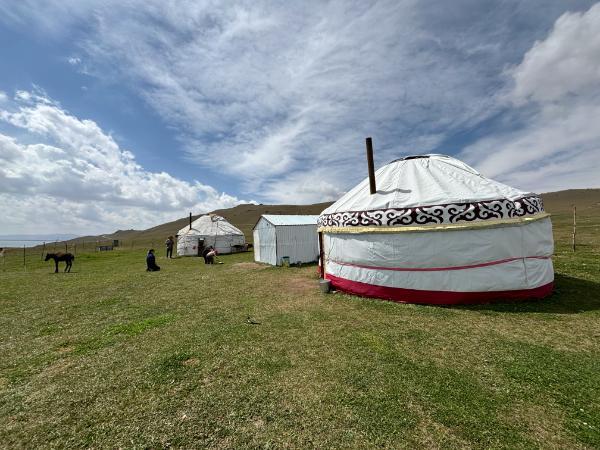
The others arrived from behind, and to my buttocks’ relief—after five hours on horseback—we finally dismounted. Rex immediately ran off to sniff his local friend, who was also a German shepherd. Sanzhar first unsaddled and hobbled the horses, letting them graze limpingly, and accompanied us into the camp.
The camp consisted of three yurts and a makeshift tin shack enclosed by a fence of branches and wire. Nearby, there was an outdoor toilet and a compost pit for organic waste. A thin rubber hose channeled water from the stream above, spilling it onto the grass behind one of the yurts, which served as a kitchen. The other two yurts were guest accommodations, and one of them was reserved for us tonight. The hosts lived in the tin shack.
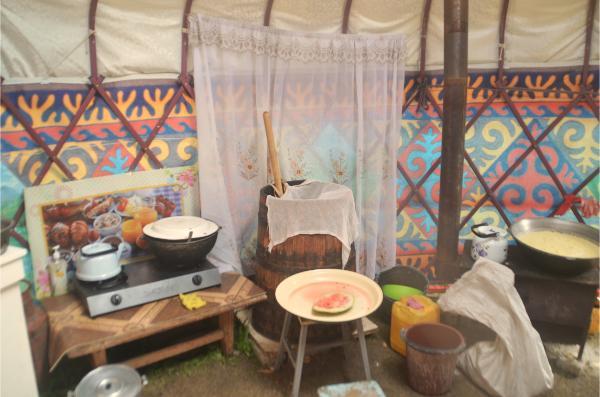
With the head of the family away on his rounds, present at the time were the mother, a teenage son, and a toddler. Everyone was busy. The woman was preparing a meal, the lad was milking mares and churning milk into butter using a contraption equipped with a clever pulley mechanism of straps and poles, and the toddler, along with another little one from the neighboring camp, was playing, shouting, wrestling, and pestering a half-shorn foal.
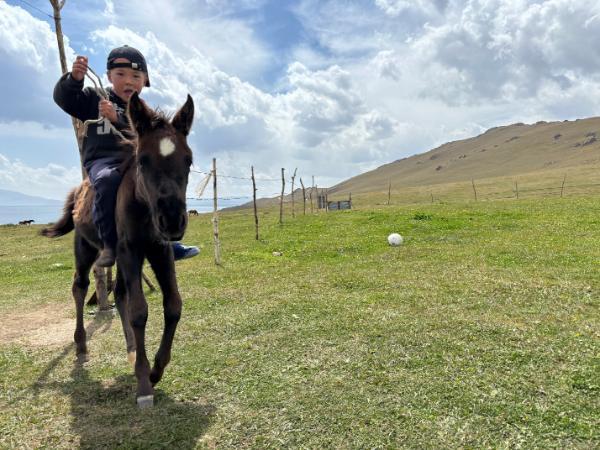
Before long, the hostess called us inside for lunch. On the table were tea and coffee with mare’s milk, freshly baked bread with butter and jam, peanuts, tomato-cucumber salad with dill, a skillet of beef and potatoes, and a large watermelon. Exhausted from the journey and stuffed from the feast, we decided to rest for a while.
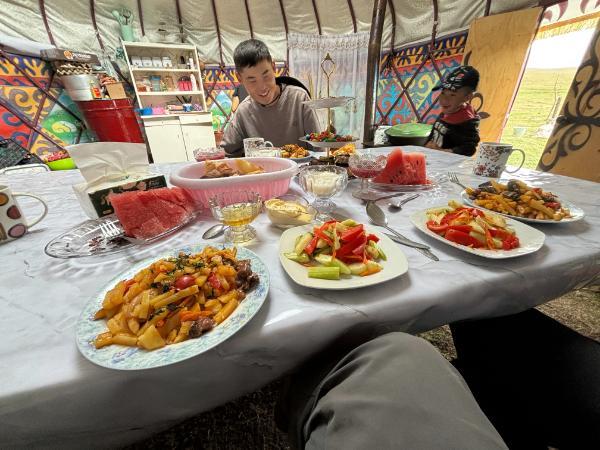
We entered our well-crafted yurt. Its frame of wooden branches was partially covered with colorful wall tapestries. On a floor of pallets overlaid with woven mats lay a row of mattresses and blankets. We collapsed instantly. But the toddler—whose friend had been taken home by his mom and who now seemed lonely—had other plans.
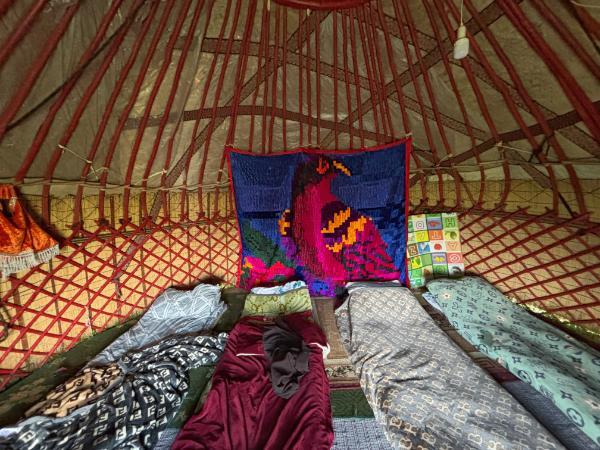
Just as I was drifting off, I perceived light entering the yurt. I opened my eyes to see the door—a hanging piece of felt—pulled aside. Standing at the entrance was the little rascal, a mischievous grin on his face and a plastic toy bow in his hand. The next moment, a suction-cup arrow whizzed past my head, followed by a burst of uproarious laughter in my ear. I shouldn’t have reacted, but I did. I retaliated with an imaginary bow and emboldened him for good.
He returned with a toy machine gun. Undeterred, I pulled the pin from my imaginary grenade and lobbed it at him. He dodged it and disappeared for a few minutes. Thinking that I had daunted him and won, I began to relax—only to be ambushed when he reappeared in the doorway with a corporeal plastic hand grenade, which he pulled the pin from with his teeth before tossing it onto my bed. The battle continued for a while, mostly one-sided after I “surrendered,” faking my cinematic demise and falling back asleep.
Peace had been restored by the time I woke up late in the afternoon. The family and Sanzhar were all resting in their beds. The dogs and the foal lay sprawled in different spots, and only the horses remained awake, still grazing nearby. I sat back and enjoyed the stillness and the soft sunlight that had followed the rain that passed while I slept.
The mother was the first to rise and returned to the kitchen to resume cooking. Later, the toddler came out, cheerful as ever, carrying a kite. We flew it together, and after everyone else got up, we snacked on buttered bread as a light pre-dinner meal before gathering and resaddling the horses for a sunset ride.
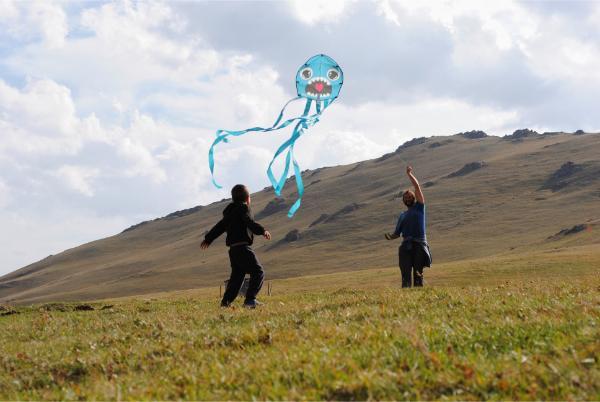
Together with the toddler perched on Burul’s neck in Sanzhar’s lap, we descended to the lakeshore, where the animals quenched their thirst. Sanzhar then headed to the lower camp to visit some friends, while Sophie and I wandered the hills, taking in the views. Zherde Sulu was in high spirits, galloping eagerly at the slightest encouragement. The moment conjured an overwhelming sense of freedom.
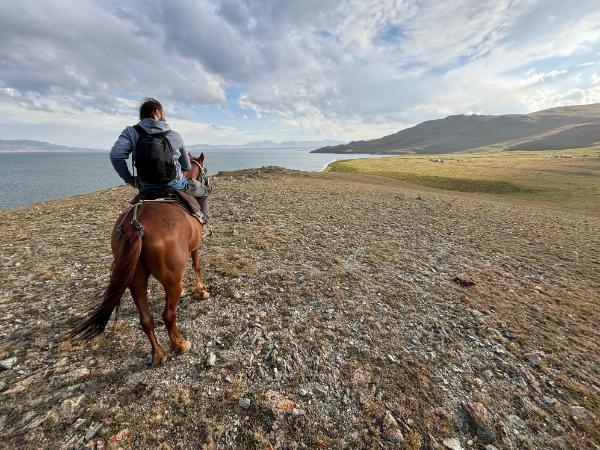
We returned at twilight, enjoyed a grand dinner, and lingered outside to soak in the solemn enchantment of the night. Sparse, faint lights from lone camps dotted the pitch-black expanse around the lake. Countless stars and the Milky Way flooded the sky with brilliance. When the cold became unbearable, we lit the woodstove and crawled under the blankets.
After a hearty breakfast the next morning, we mounted our horses and returned to the village the same way we came. It took me a few days to sit comfortably in a chair again, but the pain was well worth it.
We spent a day resting in Kyzart, then headed to Bishkek for a few days before crossing into Kazakhstan.
Activities in Kyrgyzstan
Photos
View (and if you want use) all my photographs from Lake Son-Kul in higher resolution.
